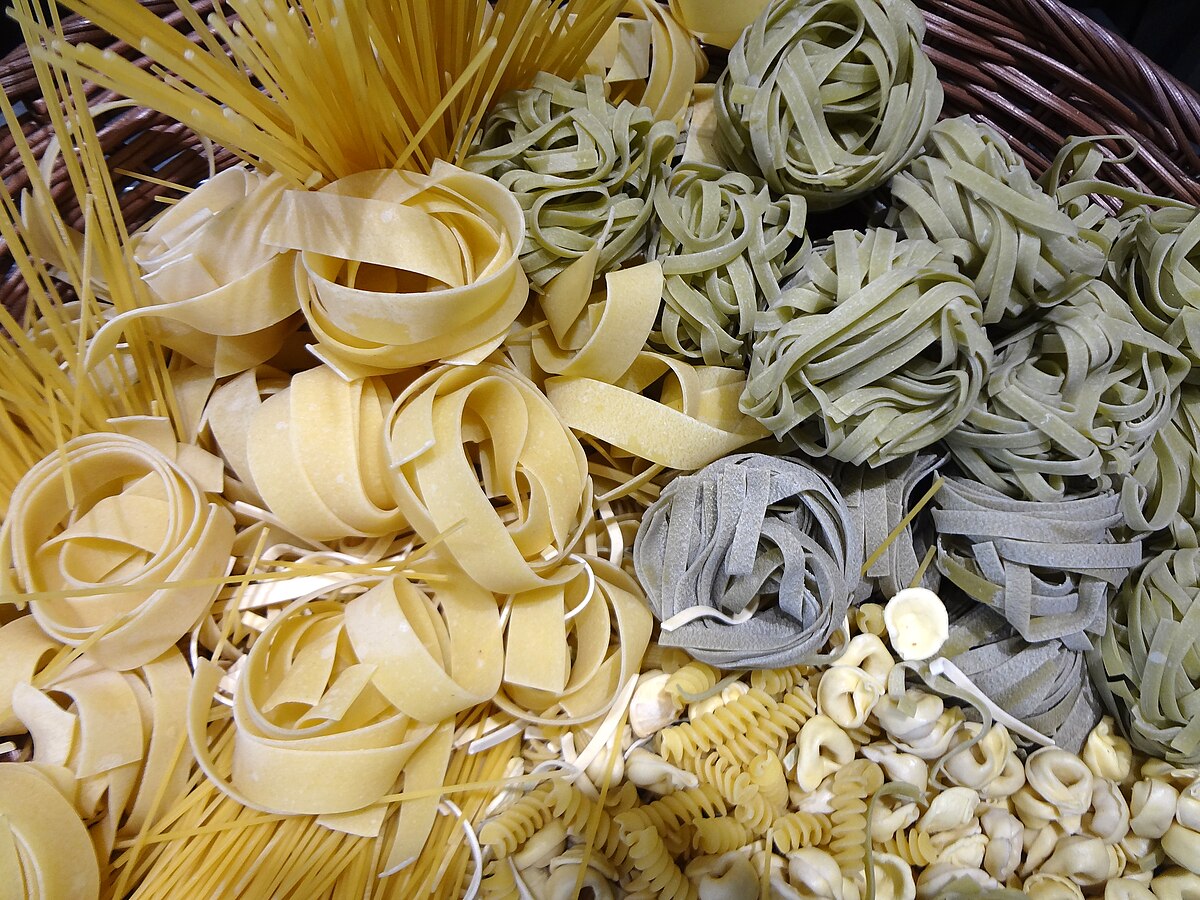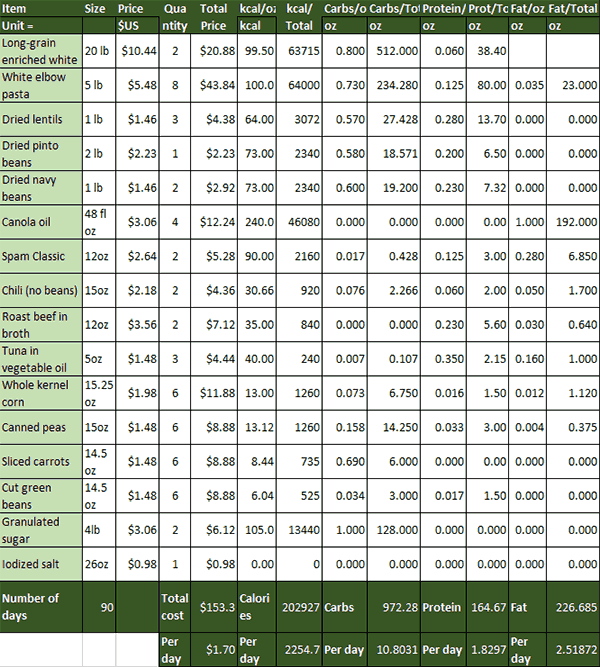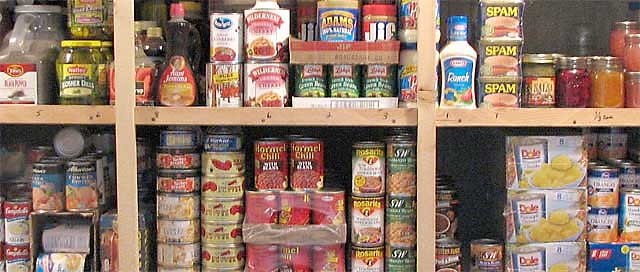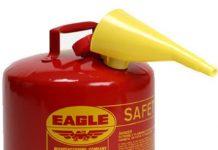One of the main obstacles that people see when they think about planning is expense. They would like to be able to survive a big disaster, but they actually do not think it is possible. Which really is not shocking. After all, according to estimates from the USDA, the total cost of feeding a family of four for a week is more than $200. Over two weeks, the bare minimum you can find as an emergency food fund is adequate, and how many of us can afford to spend $400 on extra food? Realistically, you would be looking at a three month food supply to withstand a nuclear attack or similar catastrophe. That’s 13 weeks – $2,600 extra. It’s no surprise that most people look at the numbers and agree that it’s just not possible though they’d like to be prepared.
Cheaper alternatives are available but they are not much cheaper. For a little over $100, you can get a bucket of dehydrated food that promises to feed four people a week, but that’s based on an energy consumption of only 1,822 calories a day. That’s not the point of hunger – actually – but you will still be pretty hungry. Realistically, however long this form of food pack claims it will last, about a quarter of it can be removed. When it says they’re going to feed you for a week, plan on five days. Which means that the value of 90 days is 18 buckets – almost $1,900, plus vat.
Related: The Biggest Stockpiling Mistakes
The good news is that anything like this doesn’t have to cost an emergency food supply much. After all, you don’t buy regular food, so this is survival food – the aim is to keep you alive and safe. There’s a lot of the expense of your weekly supermarket stuff that doesn’t have to go into your stock in emergency. You should focus on inexpensive basics, instead.
If you’re searching online, you’ll find survival food lists that say you can build a food reserve at a cost of one dollar a day per person. In reality, this is relatively simple to achieve. The only downside is that they typically plan to provide food for two to three weeks, and this is reflected in the nutrition they offer. If you want to buy a full 90-day supply, it will cost a bit more – but not much more. Here’s how to create a three-month supply of survival food for less than $155 a person – just $1.70 a day.
The Basics
Your prime priority is having enough energy to keep you alive. I’ve aimed for a target of about 2,250 calories a day – far more than most stocks of emergency food. The majority of this will come from carbohydrates, adding protein and fat to balance.
Dry products are the cheapest, and long-lasting sources of both carbohydrates and protein. This menu is focused on three staples – rice, pasta and dried pulses to take advantage of that. They are easy to store, can be bought in bulk and are highly versatile. Cooked rice or pasta can be easily flavored or combined with other ingredients to provide a meal that is energy rich.
The basic daily intake is broken down into 6.5 ounces of rice, 6.5 ounces of pasta and 3 ounces of beans or lentils to provide the right balance of carbohydrates and protein. These are all dry weights, and will be more than double that until they’re cooked. Clearly you don’t have to eat exactly that amount every day; you can have pasta one day, rice the next, and beans or lentils added anywhere you want. What matters is the daily intake you take.

Just go for white when buying rice. The bran coating on brown rice makes it more nutritious, but it also contains oils that go rancid after a few months – if properly preserved, white rice can last almost forever. Go for rice with long grain which has a slightly higher protein content. Parboiled rice has a higher vitamin content; it is even better for enriched rice, so go for it if you can. Purchase twenty-pound bags and you can get a pound of it for less than 50 cents. Get 40 pounds of rice per person to give you a three-month supply.
Of the same reason, white pasta is also the better option – whole grain pasta includes oily husks, which can rancid very easily. Beyond that, it doesn’t matter much what kind of pasta you get. You can get a range of shapes for around a dollar a pound if you stick with your own brand and buy it in bulk bags. Again, you’re going to need 40 pounds of pasta per person.
A more effective way to add calories is to add sugar. Many nutritionists say that sugar is “empty” calories but that’s not true. In a survival scenario, all calories are necessary and one ounce of sugar a day is going to give you another 100. This is most commonly found in tea or coffee. Store six kilograms of sugar per human.
We’ve been looking mostly at carbs so far, while rice and pasta do contain some protein. Add dried beans or lentils, to boost that. They are rich in protein, and contain dietary fiber. You can also add some variety here; there are lentils, chickpeas and different types of beans available, and although they cost more than rice or pasta you can still get them for less than $1.50 a pound.
You’ll probably need some fat in your diet. Canola oil is the best choice here; it is inexpensive, flexible and nutritious – it is low in saturated fats and helps to lower cholesterol levels. Adding two ounces a day to your diet will provide you with a sufficient intake of fat and about 400 more calories a day. Add 1.5 gallons of oil per person, to last three months.
Related: Why Are Food Prices Increasing One Month into the Corona Virus Pandemic?
Rounding it out
This simple diet will keep you going for 2-3 weeks, and maybe up to a month. Nonetheless, after three months, you will be low on certain vital nutrients – and also potentially incredibly bored. You can add some extras if you want to survive for this long time. These are going to make the diet more healthy, and much tastier.
Salt is paramount. The traditional modern American diet contains too much sodium, but your body requires enough to stay alive – so it doesn’t contain enough of the simple rations that we looked at. There is plenty of a quarter ounce of salt a day; it will add flavor to food and keep the nervous system running. You will need 1.5 kilograms of salt per individual.
If you’re not a vegetarian you’re going to miss meat. Adding one ounce a day to your diet will make it much more palatable and meat is also a good source of iron and protein. Any meat will do – bacon, canned beet or chicken, tuna or whatever you want. Chili or chili canisters are also a popular alternative. Thanks to the size of standard cans and opened storage issues, you would find it easier to have greater quantities of meat every few days rather than an ounce a day. Aim for the equivalent of six 15-ounce cans per person.
Related: Survival Kits for Every Emergency
Vegetables are a nice addition to that too. These also make food more interesting, and contain carbs and sometimes protein as well as sugar. Whether you use snap-on lids for the cans or transfer leftovers into Tupperware, sealed vegetable cans can be easily stored for a few days. Only vegetables are fairly cheap so you can get 24 15-ounce cans per person.
Finally, add a few things to add variety and flavor. Hot sauce, herbs and spices, vinegar, garlic powder and tomato paste all from simple ingredients for you to make tasty meals. All of this is something you can throw into a bag when you leave the house and head to your shelter, so you may decide not to add it to your actual supply of emergency. Just don’t forget instant coffee or teabags and get a supply of creamer if you need it.
So, now we have a basic list of food for each person. You can find more detail on our spreadsheet, but this is your shopping list:
• White long grain rice – 40 pounds
• White pasta – 40 pounds
• Dried pulses – 17 pounds
• Canola oil – 1.5 gallons
• Granulated sugar – 6 pounds
• Iodized salt – 1.5 pounds
• Canned meat – 90 ounces
• Canned vegetables – 22.5 pounds


These amounts were rounded to the nearest convenient unit, so you’ll have a tiny amount of slack if you stick to the recommended daily intake. You can get just over six pounds of sugar at Walmart, for example, by buying one 4 lb and two 20 oz bags – but it’s easier to have two 4 lb bags, so you end up with more sugar too. Obviously, if two of you only buy three bags, that’s going to reduce the cost per person.
This diet is built to be as economical as possible, but still provide ample energy and nutrients to keep you going at a time for months. This works much better than buckets of emergency food, and has more energy too. This also allows you the versatility to make fun meals by adding a few easy extras you’ve already got in your kitchen.





















